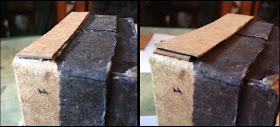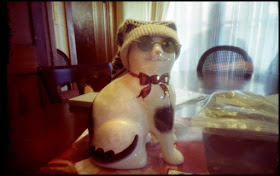In our last episode on stereo photography, I noted that 3D effects diminish in impact when you get too far away. With a 6cm baseline between pinholes (based on the dimensions of a human face) on a 45mm 6x6cm format camera, once you’re 15 meters or so away from something, it’s looks no nearer than an object on the horizon.
But what if you had a one meter separation? Now that would take a big stereo camera. Or two regular cameras. Or one camera that you just moved over a bit and made two exposures being careful to keep the camera level and pointing in exactly the same direction. The extension of the baseline beyond normal human dimensions is known as hyper stereo and the method of moving a single camera between two exposures is known as Cha-Cha. I’ve played with Cha-Cha before reducing the baseline to get close up, but only once to extend the baseline to add dimension to subjects farther away and that was only to about 25cm.
I took two film cans and filled them with brass square nuts (1/4 x 20 of course) and tied a piece of butcher’s twine between them so I could quickly define a straight line on the ground. That line has to be parallel to the film plane. If you make sure the camera is pointing exactly between two tripod legs you can just extend the line those legs define. Take one picture and then, making sure the tripod legs stay completely extended, hence the camera stays level, move it on down the line to the other end and take your second exposure.
Anything moving isn’t going to get rendered in 3D if it’s recorded at all. It was dark and foggy when I did this so I didn’t think moving objects were going to be a problem and the light wasn’t likely to change very quickly.
The internet says that the closest thing your brain can handle is a 1:30 ratio between the baseline and distance to the subject. The distance across an intersection is about 30 meters so the one meter baseline should work. I decided to use the slightly longer-than-normal 100mm front of the Variable Cuboid so I could fill the frame with the buildings at this distance.
These are set up for crossed eyes (click here for how to do it) and as anaglyphs for those with red/cyan glasses.
Just down the block another church on Church Street is the former First Baptist Temple. The stereoview in the archive is of their second church on this site. This is the third. The congregation just recently moved to another location and put it up for sale.
One of the archival stereo views is of the Beckwith Hotel, now the New Moon Coffeehouse. You do need a nice flat spot wide enough for both positions of the tripod. It has been snowing for five days so most street corners are a little messy with piles of snow. On the corner of Algoma and Main, the spot I needed to get the picture from included several slushy piles and the camera was tilted both vertically and horizontally between exposures. The right side was composed the way I wanted, but the left was rotated about 5 degrees and tilted down. I rotated, moved and aligned it and then cropped them both to match. I think I got them to match fairly well. I don’t have any trouble getting this one together crosseyed, but it takes a little concentration to get the anaglyph to pop out. This was just across the street and not all the way across an intersection so it also might be a little closer than that 30:1 minimum. I think one issue might be that you have to slightly cross your eyes like you do trying to look at something very close up.
I thought the archive included a view of the opposite corner of Main and Washington, but before Woolworth's built this Art Deco store now occupied by the Exclusive Company. It turns out it was one block down at Main and High. This one only needed about a degree rotation, but it also had to be aligned up and down. It’s actually a few feet nearer than the previous picture but this one is pretty good. It pops into 3D easily and that awning nearly seems to stick out of the picture.
There is a stereoview of Main Street looking North in about 1871 that must have been taken from the roof of a building. Right next to the river, there is a skyway between the hotel and the conference center crossing over Main Street. It was nice to be indoors with a nice flat floor to work on. Complicating this one were the reflections of structural elements of the skyway in the windows. The street lamp at the bottom is too close, only about 10m away, but if I concentrate on it, I can get it into 3D, but then the rest is out of alignment.
One of the stereo views is of the first Main Street bridge five years after the first permanent wooden bridge was built. The reflections with this one were less of a problem. I just used the bottom of the skyway window to keep the camera level and parallel. I was close enough to the window so that standing behind the camera, the reflection, or lack thereof, of my black coat filled the frame and eliminated most of the unwanted reflections.
I don’t mean to cause anyone eyestrain. I think I might set up a few of these pairs for a stereoviewer and make prints to see if I can subject the public to looking at these.


















































